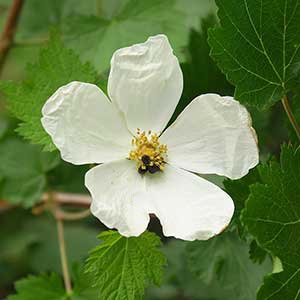Rubus bartonianus
Rubus idaeus
red raspberry
Leaves alternate, usually trifoliate, the leaflets ovate-oblong to broadly lanceolate, 4-10 cm. long, irregularly biserrate, green and glabrous on the upper surface, usually gray-woolly beneath.
Flowers several, 1-4 per axil, forming a leafy, racemose inflorescence;
calyx somewhat woolly to bristly-glandular, the 5 lobes reflexed, lanceolate, 4-8 mm. long;
petals 5, white, ascending, narrowly oblong, 4-6 mm. long;
stamens 75-100, glabrous;
pistils numerous, styles slender
Drupelets weakly coherent to form a red raspberry, finely short-woolly.
Rubus bartonianus
Rubus idaeus
Occurring chiefly east of the Cascades crest in Washington; Alaska to California, east across most of North America to the Atlantic Coast.



